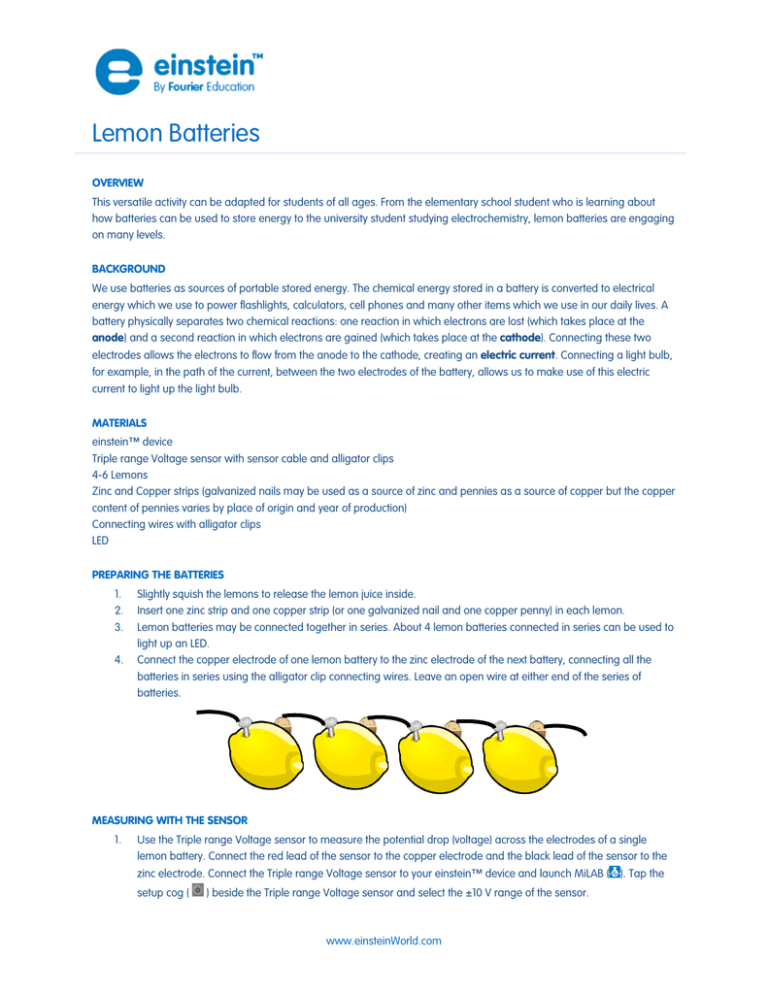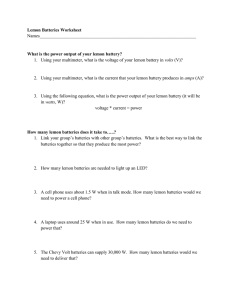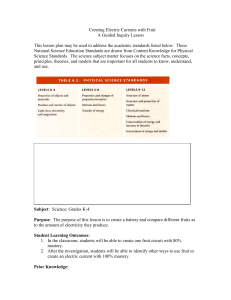Lemon Batteries
advertisement

Lemon Batteries OVERVIEW This versatile activity can be adapted for students of all ages. From the elementary school student who is learning about how batteries can be used to store energy to the university student studying electrochemistry, lemon batteries are engaging on many levels. BACKGROUND We use batteries as sources of portable stored energy. The chemical energy stored in a battery is converted to electrical energy which we use to power flashlights, calculators, cell phones and many other items which we use in our daily lives. A battery physically separates two chemical reactions: one reaction in which electrons are lost (which takes place at the anode) and a second reaction in which electrons are gained (which takes place at the cathode). Connecting these two electrodes allows the electrons to flow from the anode to the cathode, creating an electric current. Connecting a light bulb, for example, in the path of the current, between the two electrodes of the battery, allows us to make use of this electric current to light up the light bulb. MATERIALS einstein™ device Triple range Voltage sensor with sensor cable and alligator clips 4-6 Lemons Zinc and Copper strips (galvanized nails may be used as a source of zinc and pennies as a source of copper but the copper content of pennies varies by place of origin and year of production) Connecting wires with alligator clips LED PREPARING THE BATTERIES 1. 2. 3. 4. Slightly squish the lemons to release the lemon juice inside. Insert one zinc strip and one copper strip (or one galvanized nail and one copper penny) in each lemon. Lemon batteries may be connected together in series. About 4 lemon batteries connected in series can be used to light up an LED. Connect the copper electrode of one lemon battery to the zinc electrode of the next battery, connecting all the batteries in series using the alligator clip connecting wires. Leave an open wire at either end of the series of batteries. MEASURING WITH THE SENSOR 1. Use the Triple range Voltage sensor to measure the potential drop (voltage) across the electrodes of a single lemon battery. Connect the red lead of the sensor to the copper electrode and the black lead of the sensor to the zinc electrode. Connect the Triple range Voltage sensor to your einstein™ device and launch MiLAB ( setup cog ( ) beside the Triple range Voltage sensor and select the ±10 V range of the sensor. www.einsteinWorld.com ). Tap the 2. Begin by measuring the voltage from a single lemon. Tap the setup cog ( 3. Tap Run ( ) to begin measuring the voltage. After you have measured the voltage from a single lemon battery, leave one lead connected to the lemon on one end and move the second lead from one battery to the next in the series to measure the voltages along the series of lemon batteries. An LED may be connected to the series of batteries, using the two open connecting wires on either end of the series. About 4 lemon batteries should be enough to light up an LED. When the LED is connected, you should observe a drop in voltage across the series of batteries. second for 5 minutes. You may want to open the Meters window ( 4. ) and set up to measure 10 times per ) to see a digital display of the results. UNDERSTANDING THE MEASUREMENT You began by measuring the electromotive force of a single lemon battery by measuring the potential drop (voltage) across its two terminals. This measurement is called the open circuit voltage because the battery is not connected as part of a circuit. When batteries are connected in series, their voltages add to each other. You can measure the voltage of 2, 3 and 4 lemon batteries connected in series to observe the voltage increasing. Next, you can observe the voltage drop across the batteries when a load is added to create a circuit. In this case the load is the LED which is connected to the four lemon batteries in series. UNDERSTANDING THE SCIENCE Two chemical reactions occur in the lemon battery, one at each electrode. At the zinc anode, zinc is oxidized, meaning that it loses electrons: Zn(𝑠) → Zn2+ (𝑎𝑎) + 2e− When the zinc anode is connected to the copper cathode these electrons are able to flow from the zinc to the copper where H+ ions of the acid are reduced, meaning they gain electrons, and form hydrogen gas H2: 2H + (𝑎𝑎) + 2e− → H2 (𝑔) It is important to note that the copper serves as a conduit for the electrons, allowing them to flow from the zinc to the H+ ions but that the copper does not take part in the chemical reactions. Even more important to understand is that lemons by themselves are not batteries. The acid of the lemon together with the zinc of the galvanized nails or zinc strips provide the materials for the two chemical reactions of the battery. REFERENCES Goodisman, J.; J. Chem. Educ. 2001, 78, 516. www.einsteinWorld.com

